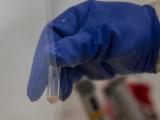Jan 22, 2001 (CIDRAP News) The case of a postal inspector who handled anthrax-tainted equipment and came down with a lingering anthrax-like illnessbut never had clear evidence of the organism in his bodycontinues to puzzle his physicians nearly 3 months after he first got sick.
The 37-year-old man was hospitalized in late October with severe chest pain, cough, headache, chills, and sweatinga picture that looked a lot like inhalational anthrax. He still had not fully recovered last week, according to Tyler C. Cymet, DO, one of his physicians at Sinai Hospital in Baltimore.
Cymet and his colleagues, who published a case report in the January issue of the Journal of the American Osteopathic Association, are reluctant to believe the man's illness was unrelated to anthrax, despite the lack of positive evidence. They titled their report "Symptoms Associated with Anthrax Exposure: Suspected 'Aborted' Anthrax."
"We're definitely not saying this is anthrax, we're just saying that this is a possibility we need to keep in mind," Gary J. Kerkvliet, MD, second author of the case report, told CIDRAP News last week.
The patient inspected a sorting machine at the Brentwood postal facility in Washington, DC, about Oct 18 or 19, before the facility was known to be contaminated with anthrax, according to Cymet and colleagues. The Brentwood facility had processed the anhrax-laden letter that was opened in Sen. Tom Daschle's office Oct 15 [and other letters?]. The inspector also removed some air filters in the contaminated area while wearing only a simple, store-bought face mask, inhaling "large quantities of dust particles in the process," according to the case report.
Three days after inspecting the equipment, when his exposure became known, the patient was given a 10-day course of ciprofloxacin. He took the medication for 1 day (two doses), but then missed two doses because he was away from home and forgot to bring the drug along, according to Cymet. He then became ill with headache and cough.
The patient was admitted to the hospital Oct 24 with severe chest pain, worsening cough and headache, and diaphoresis and chills, according to his physicians. He also had a low blood oxygen level of 72; an initial chest radiograph suggested a possibly widened mediastinum, but a computed tomographic (CT) scan was normal. Because anthrax was strongly suspected, he was placed in intensive care and started on ciprofloxacin, penicillin, and clindamycin hydrochloride, along with narcotics for the chest pain. His symptoms improved with this treatment, and after 5 days in the hospital he was sent home with instructions to keep taking ciprofloxacin, according to Cymet.
But shortly after his discharge, the patient experienced renewed chest pain along with dyspnea, malaise, and diaphoresis. His antibiotic was changed from ciprofloxacin to doxycycline, but the symptoms worsened, according to the report. Just 3 1/2 days after going home, he was readmitted to the hospital, Cymet said. Evaluation at that point showed continued hypoxia, a small pleural effusion, and a possibility of lymph node calcification in the mediastinum on CT scan, though a ventilation perfusion scan was negative.
The patient's chest pain and dyspnea, along with intermittent fever, continued until he was put on ciprofloxacin, clindamycin, and doxycycline, according to the report. The fever and effusion improved and the patient felt better rapidly with this triple regimen, but the hypoxia didn't improve right away, Cymet said. In addition, he said the patient continued to have some chest pain. The man spent a total of 45 days in the hospital.
By last week, the patient was "still tired, weak, and wornout, but that may be due to the deconditioning," Cymet said. Though the patient had not yet returned to work, "We feel confident that he's getting better," Cymet added.
Laboratory tests consistently failed to confirm the presence of anthrax in the patient's body, according to his physicians. A blood culture for anthrax, taken during the patient's first hospitalizationa few days after he was started on ciprofloxacinwas negative. In addition, Kerkvliet said tests for antibodies to anthrax and polymerase chain-reaction (PCR) tests for anthrax DNA also failed to detect the pathogen. These tests were conducted by the CDC in the acute stage of the illness, again a few weeks later, and again about Jan 11, he said. No fluid from the patient's pleural effusion was tested for anthrax because the effusion was too small, Kerkvliet said.
Despite the lack of definitive evidence, Cymet and colleagues find it difficult to blame their patient's illness on anything besides anthrax. The case report says the patient's coworkers at the Brentwood facility were culture-positive for inhalational anthrax, and his physiologic changes were temporally related to his exposure and had no other valid explanation. The patient's house had been fumigated a month before he became sick, but the physicians consider that an unlikely cause of the illness, in view of the man's anthrax exposure.
"In the absence of an alternative diagnosis for this patient, and because an anthrax diagnosis was not made definitively, we suggest that there may exist a clinical entity of 'aborted anthrax infection,'" the case report states. Cymet speculated that anthrax organisms were originally present and survived long enough to release their toxins, triggering the illness. He noted that nine consultants evaluated the patient and couldn't agree on the cause of his condition.
The patient had been on ciprofloxacin about 5 days when the first blood culture test was done, which suggests the possibility that the antibiotic could have killed off any anthrax in the blood by that time, according to Kerkvliet. But he adds, "The question is, Why would this guy not have developed antibodies? The antibiotics wouldn't have done anything to that process. We don't know. Maybe it's proof that he didn't have anthrax."
He said it's possible that antibodies were missed by testing in the early stage of the illness, but the subsequent negative tests increased the weight of evidence against the presence of anthrax.
CDC officials have said they concluded that the patient didn't have anthrax. Said Cymet, "The [CDC] criterion for anthrax diagnosis is a positive blood culture, and he never had one." However, he said there are two previous reports of anthrax-related deaths in which blood cultures were negative. A 1977 report from the US Army Research Institute of Infectious Diseases tells of a patient who died in 1951; blood cultures were negative, but an autopsy revealed anthrax in brain tissue. In addition, a 1993 article by Arthur Friedlander and colleagues in the Journal of Infectious Diseases reported a study in which monkeys were exposed to anthrax and then treated with antibiotics for 30 days. For three monkeys that died, "They couldn't find any reason for the deaths," Cymet said.
The two physicians are continuing to monitor their patient carefully. "I think for me the most nervous time will be when he comes off the antibiotics," said Kerkvliet.
See also:
Cymet TC, Kerkvliet GJ, Tan JH, et al. Symptoms associated with anthrax exposure: suspected 'aborted' anthrax. J Am Osteopathic Assoc 2002;102(1):41-3 [Abstract]
Friedlander AM, Welkos SL, Pitt ML, et al. Postexposure prophylaxis against experimental inhalation anthrax. J Infect Dis 1993 May;167(5):1239-43 [Abstract]



















